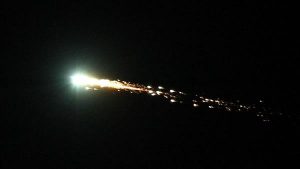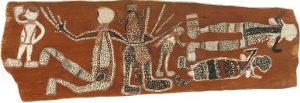Meteors

In the oral traditions of Aboriginal Australians, meteors and meteorites are prominent. Meteors are often associated with serpents, evil magic, omens of death, and punishment for breaking laws and traditions. In Central Australia, a meteor is an omen that the spirit of someone that had died far away was returning home. Meteors are believed to contain an evil magic called Arungquilta, which is harnessed in ceremonies to inflict harm or death upon someone that breaks a taboo, such as infidelity. Arungquilta could also be found in toadstools and mushrooms, which were believed to be fallen stars, and their consumption was forbidden. Such a taboo may have developed from the consumption of poisonous fungi that are found in the region.
Meteors are also a component of ceremonies. Two Arrernte rituals are performed to cause death using magical means. One involves chanting a spell over a bone or stick and throwing the stick as far as possible in the direction of the intended victim. Afterwards, if the individual performing the spell saw a meteor, it was believed to represent the spirit of the person they had killed. The second ritual, a small spear-like device designed to punish a man for stealing another man’s wife. The spear, endowed with Arungquilta, was thrown in the direction of the offending man’s home. The evil spirit within the spear would locate the law-breaker and kill him. This form of Arungquilta was seen “streaking across the sky like a ball of fire”. The men conducting the ritual would wait until a “thunderous boom” was heard, which signified that the spear had struck and killed the man. Another form of Arungquilta was used to punish unfaithful wives. The Arungquilta would find the woman and deprive her of her fat. The emaciated woman would die and her spirit (ulthana) appeared in the sky as a meteor.
In Luritja traditions, meteorites are used as tools of punishment or signs of approval. The Walanari (celestial deities who were seen as protectors of good men and punishers of bad men that live in the Magellanic Clouds) cast stones to the earth as punishment for breaking taboos or as signs of approval during totemic ceremonies. Ngalia men claimed people have been killed by stones thrown by the Walanari and said the Walanari threw glowing stones on their camp the previous night after they shared sacred information with an ethnographer. The Yarrungkanyi and Warlpiri people of the Northern Territory tell how Dreaming men traveled through the sky as falling stars and landed at a place called Purrparlarla, southwest of Yuendumu, bringing the Dreaming to the people.
Aboriginal groups across northern Australia believe that meteors are the eyes of an evil spirit with a ferocious demeanour. This spirit has many names – Thuwathu, Papinjuwari, Indada… They streak across the sky with their long claws, searching for the souls of the sick or dying. In Arnhem Land, this being is called Namorrorddo or Namorrodor. Its presence is signaled by a shooting star in the night sky and lives in a cave, hunting for food at night. At dusk it begins moving in the cave, preparing to go out hunting. It makes noise like wind, it has long claws and a head like a kangaroo.

Namorrodor transforms into a terrifying spirit creature that hunts for babies. It is known to eat their hearts. The smell of meat cooking at night attracts Namorrodor, as well as centipedes, scorpions, ants and other biting insects. The story is told to children to encourage them to behave and go to sleep. It is said that the only person who can kill Namorrodor is a clever man who has as much strength as the spirit creature. This man can only kill Namorrodor at a certain time of the night. When Namorrodor dies, it makes a terrible scream.
In the Torres Strait, Meriam Mir people see bright meteors (fireballs) as the souls of the recently deceased heading to Being – the land of the dead. These meteors are called Maier. When a person dies (or is about to die) their spirit is taken to the top of the tallest palm tree, set alight, and launched like a rocket to Beig. The trajectory of the Maier tell you where that person is from. The brightness of the Maier tells you how important they are, and if it fragments, the falling bits (weir-weir) tell you that person left behind a large family. The people wait to hear the dum, a loud booming sound. This tells the people the spirit made it home safely.
Learn More
Blogs and Media
- Dreamtime astronomers understood meteors (ABC Science)
- Finding meteorite impacts in Aboriginal oral tradition (The Conversation)
- Meteors, Meteorites, and Cosmology in Aboriginal Cultures of Central Australia (Aboriginal Astronomy Blog)
- To Find Meteorites, Listen to the Legends of Australian Aborigines (Smithsonian)
Published Research
- Hamacher, D.W. and Norris, R.P. (2010). Meteors in Australian Aboriginal Dreamings. WGN – Journal of the International Meteor Organization, Vol. 38(3), pp. 87-98.
- Hamacher, D.W. (2011). Letter – Reply: Meteors in Australian Aboriginal Dreamings. WGN – Journal of the International Meteor Organization, Vol. 39(3), p. 58.
- Hamacher, D.W. (2014). Comet and meteorite traditions of Aboriginal Australians. Encyclopaedia of the History of Science, Technology, and Medicine in Non-Western Cultures, 3rd Edition, edited by Helaine Selin. Springer-Netherlands, pp. 1-4.
- Hamacher, D.W. (2014). Geomythology and cosmic impacts in Australia. West Australian Geologist, Vol. 505, pp. 11-14.
- Hamacher, D.W. (2013). Recorded accounts of meteoritic events in the oral traditions of Indigenous Australians. Archaeoastronomy, Vol. 25, pp. 99-111.
- Hamacher, D.W. and Goldsmith, J. (2013). Aboriginal oral traditions of Australian impact craters.Journal of Astronomical History and Heritage, Vol. 16(3), pp. 295-311.
- Hamacher, D.W. (2011). Meteoritics and cosmology among the Aboriginal cultures of Central Australia. Journal of Cosmology, Vol. 13, pp. 3743-3753.
- Hamacher, D.W. and Norris, R.P. (2009). Australian Aboriginal geomythology: eyewitness accounts of cosmic impacts? Archaeoastronomy, Vol. 22, pp. 60-93.
- Bevan, A.W.R. and Bindon, P. (1996) Australian Aborigines and Meteorites. Records of the Western Australian Museum, Vol. 18, pp. 93-101.
- Cleverly, W. H. and Cleverly, E. I. (1985) Destruction of Australites by Aborigines in part of the Eastern Goldfields, Western Australia. Journal of the Royal Society of Western Australia, Vol. 68, pp. 1-8.
